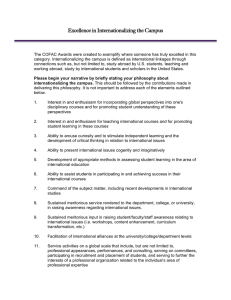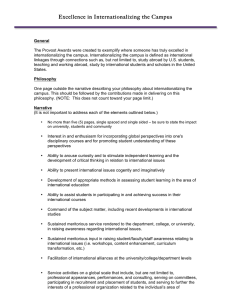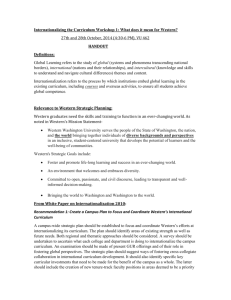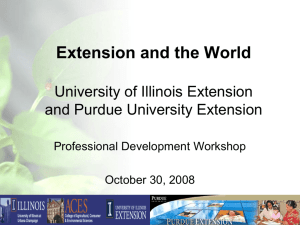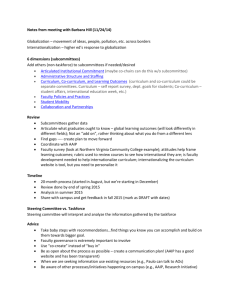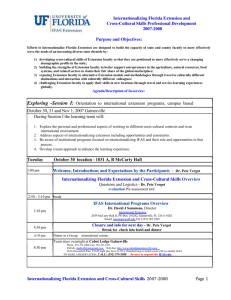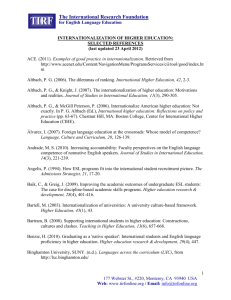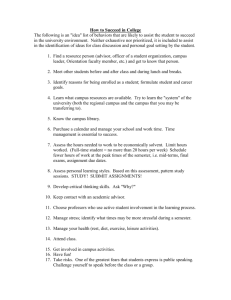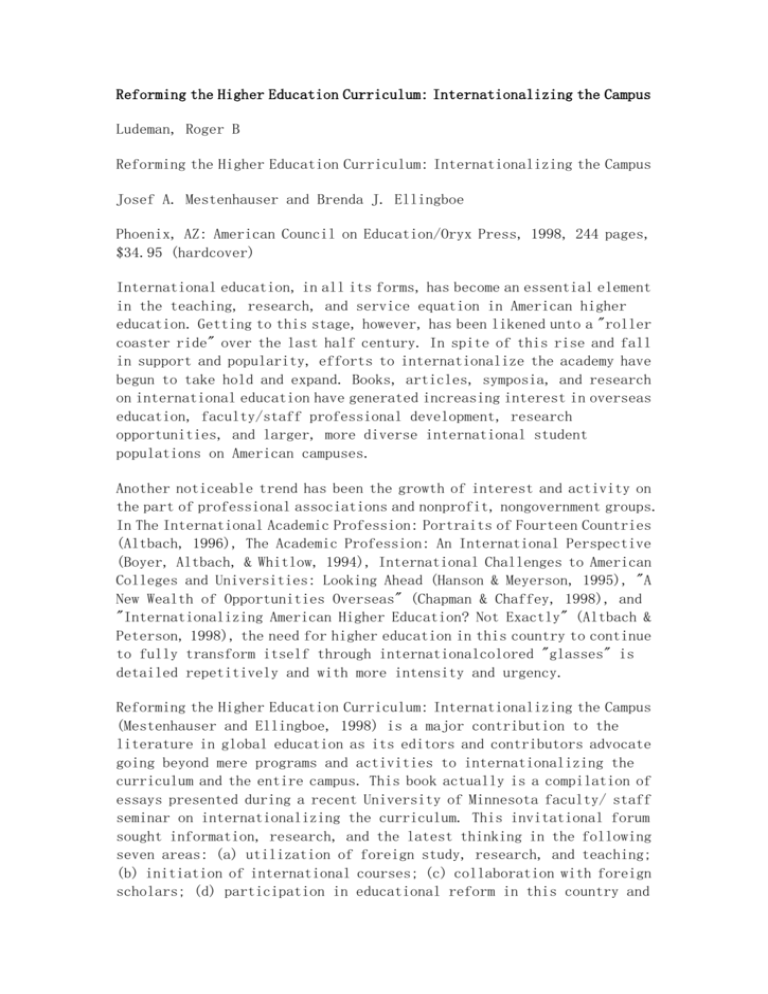
Reforming the Higher Education Curriculum: Internationalizing the Campus
Ludeman, Roger B
Reforming the Higher Education Curriculum: Internationalizing the Campus
Josef A. Mestenhauser and Brenda J. Ellingboe
Phoenix, AZ: American Council on Education/Oryx Press, 1998, 244 pages,
$34.95 (hardcover)
International education, in all its forms, has become an essential element
in the teaching, research, and service equation in American higher
education. Getting to this stage, however, has been likened unto a "roller
coaster ride" over the last half century. In spite of this rise and fall
in support and popularity, efforts to internationalize the academy have
begun to take hold and expand. Books, articles, symposia, and research
on international education have generated increasing interest in overseas
education, faculty/staff professional development, research
opportunities, and larger, more diverse international student
populations on American campuses.
Another noticeable trend has been the growth of interest and activity on
the part of professional associations and nonprofit, nongovernment groups.
In The International Academic Profession: Portraits of Fourteen Countries
(Altbach, 1996), The Academic Profession: An International Perspective
(Boyer, Altbach, & Whitlow, 1994), International Challenges to American
Colleges and Universities: Looking Ahead (Hanson & Meyerson, 1995), "A
New Wealth of Opportunities Overseas" (Chapman & Chaffey, 1998), and
"Internationalizing American Higher Education? Not Exactly" (Altbach &
Peterson, 1998), the need for higher education in this country to continue
to fully transform itself through internationalcolored "glasses" is
detailed repetitively and with more intensity and urgency.
Reforming the Higher Education Curriculum: Internationalizing the Campus
(Mestenhauser and Ellingboe, 1998) is a major contribution to the
literature in global education as its editors and contributors advocate
going beyond mere programs and activities to internationalizing the
curriculum and the entire campus. This book actually is a compilation of
essays presented during a recent University of Minnesota faculty/ staff
seminar on internationalizing the curriculum. This invitational forum
sought information, research, and the latest thinking in the following
seven areas: (a) utilization of foreign study, research, and teaching;
(b) initiation of international courses; (c) collaboration with foreign
scholars; (d) participation in educational reform in this country and
elsewhere; (e) utilization of international students or U.S. students
with study abroad experiences; (f) planning and implementation of degree
programs or concentrations with international emphases; and (g)
experiences with teaching courses that may be presumed by definition to
be "international." The seminar was very successful resulting in the
material presented by the editors in this 1998 volume.
Part 1 of Reforming the Higher Education Curriculum: Internationalizing
the Campus focuses on "Internationalization for the TwentyFirst Century."
In chapter 1, Josef Mestenhauser provides an excellent history of
international education in the US, and details the larger issue of higher
education not taking this subject and its study seriously (beyond
providing students a few international courses, foreign languages, and
experiences abroad). Kerry Freedman (chapter 2) zeroes in on the
curriculum and transforming it from the traditional look to one that is
international and interdependent in nature.
In chapter 3, Marion L. Lundy Dobbert alerts us to the problem of assuming
that internationalizing the curriculum simply means adding some
international materials across the curriculum. Instead, she points out
the importance of employing the analytic point of view of modern
structural anthropology to build a curriculum through change of the
interaction patterns within the university, including immersion
experiences, merged with intensive language study, and forcing students
to live outside their own culture for extended periods of time. Arthur
M. Harkins uses chapter 4 to be even more provocative by asserting that
internationalization is passe and we should be thinking about
post-internationalism and postculturalism. His premise is based on our
predicted use of technology to self-generate information and knowledge
for different purposes and through different methods. He calls for
universities to shift from the teachingresearch-service model to
research-demonstration-assessment resulting in "self-evolving learning
organizations" that use distance education to reach large masses of
clients in a timely way.
Part 2, "Multidisciplinary Perspectives on Curricular Change," begins
with chapter 5 that Michael F. Metcalf directs at higher education
policymakers, non-profit foundations, and government agencies. He makes
the case for expanding the availability of foreign language instruction
across the undergraduate education curriculum. In chapter 6, Herbert L.
Pick, Jr., discusses the teaching of cognition and how we think, reason,
perceive, remember, and solve problems, then relating these processes to
the difficulties we have in thinking beyond our own cultural biases. John
J. Cogan (chapter 7) discusses the importance of infusing intercultural
research and theory-based materials into readings, lecture illustrations,
other course resources, and assignments for students.
Chapter 8 by C. Victor Fung deals with the discipline of music and using
the universal and nonuniversal qualities of music to have a freeing effect
leading to openmindedness. Peter Graham uses chapter 9 to propose new
approaches to the field of agriculture, particularly in soil sciences and
agronomy. He suggests that change is necessary because of population
shifts and the international aspects of agriculture that have already been
accomplished.
Chapter 10 by Harvey B. Sarles includes the actual outline of a course
in American Studies. His contention is that by teaching international and
American students about America simultaneously, both groups will see
their own experiences by looking at each other's context as well as their
own. Finally, R. Michael Philson (chapter 11) makes the case for using
technology in internationalizing the campus by creating virtual
universities, using distance education and asynchronous learning to teach
and offer entire degree programs, and creating access for many who are
currently not able to engage in higher education. The result: achievement
of international competencies needed in today's labor market and
government service.
The last two chapters of Reforming the Higher Education Curriculum:
Internationalizing the Campus comprise part 3, "Evidence, Evaluation, and
Outcomes of Internationalization." Susan Lewis English (chapter 12)
believes that the use of outcomes assessment as a single tool to determine
if students are acquiring the necessary knowledge and skills related to
international education comes up short. She makes the case for a more
comprehensive plan that would include process evaluation and program
review in addition to outcomes assessment. In chapter 13, the book's
coeditor, Brenda J. Ellingboe, summarizes her Master's thesis in which
she used the case study approach to look closely at the
internationalization of five colleges within one large public research
university. Rationales, sources of resistance, encouraging developments,
a readiness scale for internationalization, descriptions of various
intercollegiate and intracollegiate attempts to internationalize these
colleges, and lessons learned are provided for those seriously interested
in internationalization and change.
This volume clearly reflects the comprehensive and complicated nature of
international education. Mestenhauser characterized the volume as "a
timely publication for universities, transnational institutions in their
own right, that are now entering into a new era of post-Cold War
international cooperation based on knowledge" (p. xxi). I believe that
he has made his case. The book also points out the typical way Americans
often handle complex matters. First we take complex challenges and make
them seem simple. Then we develop simple and short term solutions for those
seemingly simple challenges. Internationalization of the higher
education curriculum is a complex process requiring broad,
multidimensional, and interdisciplinary treatments along with unqualifed
support from the institutional leadership at all levels.
Reforming the Higher Education Curriculum: Internationalizing the Campus
is a serious treatment of a serious subject that requires the attention
and study from all institutional officers who believe that the global
society will play an important role in our undergraduate and graduate
programs and this country's future. As one of those institutional leaders,
the Senior Student Affairs Officer must see international education as
a fertile ground for integration and inclusion of student affairs efforts
into the web of opportunities for our students to learn and be successful
in their life work.
REFERENCES
Altbach, P. G. (Ed.). (1996). The international academic profession:
Portraits of fourteen countries. Princeton, NJ: the Carnegie Foundation
for the Advancement of Teaching.
Altbach, P. G., & Peterson, P. M. (1998 July/August). Internationalize
American higher education? Not exactly. Change Magazine.
Boyer, E. L., Altbach, P. G., & Whitlow, M. J. (1994). The academic
profession: An international perspective. Princeton, NJ: the Carnegie
Foundation for the Advancement of Teaching.
Chapman, D. W., & Chaffey, J. M. (1998, September 15). A new wealth of
opportunities overseas. The Chronicle of Higher Education.
Hanson, K. H., & Meyerson, J. W. (Eds.). (1995). International challenges
to American colleges and universities: Looking ahead. Phoenix, AZ:
American Council on Education / Oryx Press.
Mestenhauser, J. A., & Ellingboe, B. J. (Eds.). (1998). Reforming the
higher education curriculum: Internationalizing the campus. Phoenix, AZ:
American Council on Education I Oryx Press.
Reviewed by Roger B. Ludeman University of Wisconsin-Whitewater
Copyright American Counseling Association Nov/Dec 1999
Provided by ProQuest Information and Learning Company. All rights
Reserved

